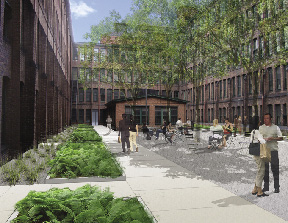Columbia Construction is serving as construction manager for the first phase of restoring and rehabilitating the historic Watch Factory complex. The Waltham Watch Co. began making watches at the property in 1854 and operated for over a century. The complex's regimented rows of windows lining long, narrow wings show how important daylight once was for the production of pocket-sized timepieces. Watch City Ventures LLC, a joint venture between Berkeley Investments and The First Republic Corp. of America, acquired the property in May 2007. Berkeley Investments, a Boston-based real estate investment and development company, is overseeing the multi-phase redevelopment process and managing the property.
The rehabilitation and adaptive reuse of this historic 400,000 s/f complex, comprised of 22 interconnected buildings, will occur in three phases and provide a vibrant mix of office, residential and retail uses with riverfront amenities. The first phase, currently under construction, consists of 177,000 s/f of core & shell office space characterized by sandblasted brick walls, exposed wood ceilings, and abundant natural light. Phase I will also provide a Waltham Watch Company history exhibit; a fitness center; and landscaped courtyards that create a campus-like environment.
In June 2007, Columbia, Berkeley Investments and architect, Bruner/Cott & Associates rolled up their sleeves and began the rigorous work of a nine-month preconstruction process for the first phase. The National Parks Service and Mass. Historical Commission reviewed and approved all proposed improvements because of the historic significance of the Watch Factory, and because Berkeley Investments is using both Federal and State Historic Rehabilitation Tax Credits.
Construction began with demolition and abatement in March 2008. Activities included removal of several buildings that lacked historical significance in order to open up courtyards and improve site circulation.
The only new construction in this first phase is a second-level bridge connection between two buildings that spans an open-ended courtyard and creates a more cohesive layout for office use.
The first phase also included the restoration of slate roofs on the steep slopes of the core buildings. Additionally, the removal and abatement of flat roofs was required in some areas, which were replaced with new TPO-rubber roofing and zinc-coated copper flashing. Careful coordination was required in these areas because of the complex array of towers and finials as well as a series of large saw-tooth skylights. The latter was retrofitted to comply with National Park Service architectural requirements. MEP for the core building included rooftop units, air-handling units and cooling towers. Careful consideration was given to the flues, as well as fan penetrations and the placement of rooftop mechanical units, so they would not intrude on the aesthetics of this historic treasure from its many public façades.
Interior renovation work included a 20,000 s.f. build-out of prime space for Passkey, a company that provides an online group reservations management and distribution system for travel and meeting planners.
Construction for Phase I of this project is scheduled for completion this coming May.
Tags:
Columbia Construction serves as CM for Phase 1 of 400,000 s/f adaptive reuse of historic Watch Factory - project team includes Rockwell Roofing, Glynn Electric, AVID Engineers, NER Construction, Grubb & Ellis, A-1 Concrete, DM Berg and Kaloutas Painting
February 18, 2009 - Construction Design & Engineering
 (1).jpg)









.png)